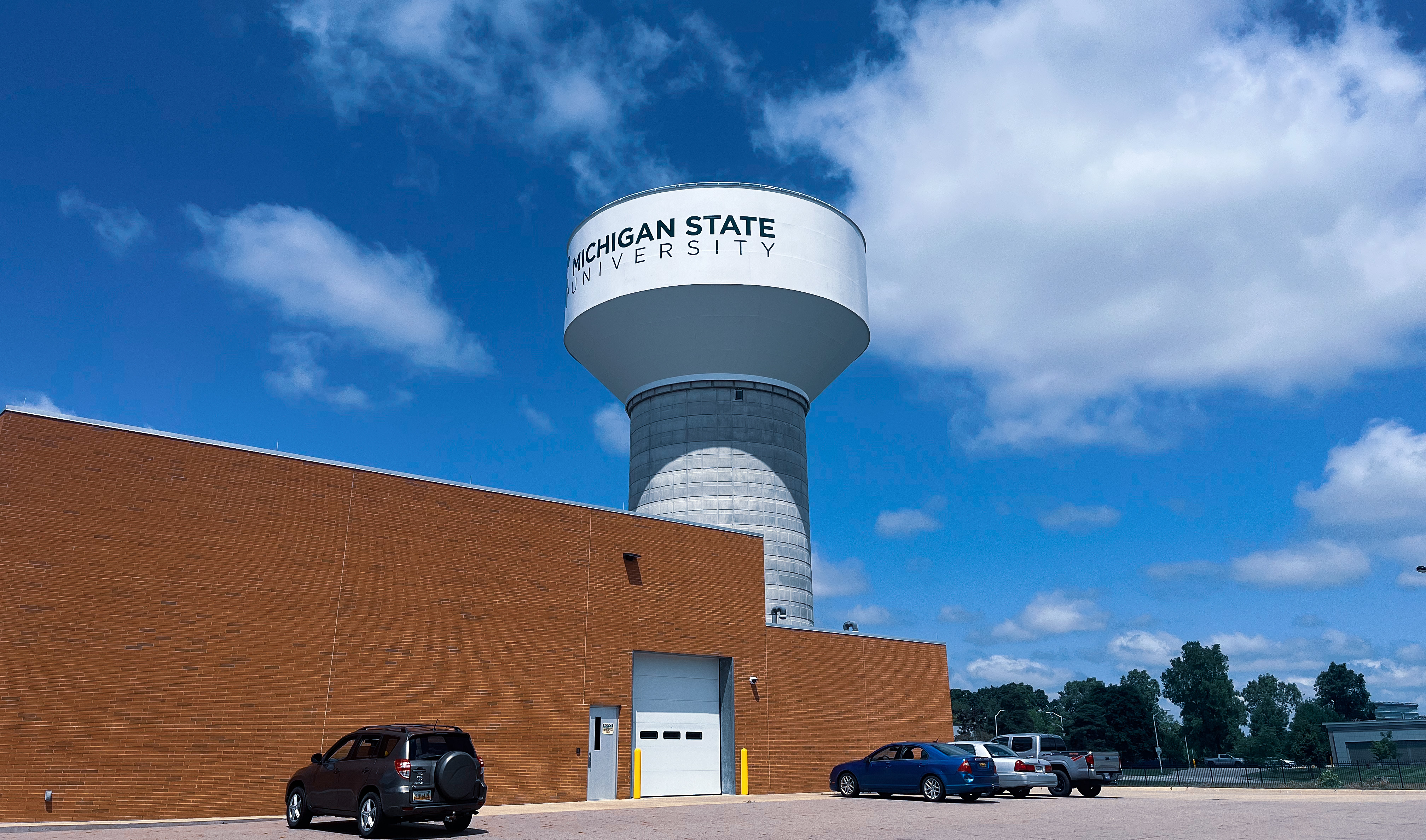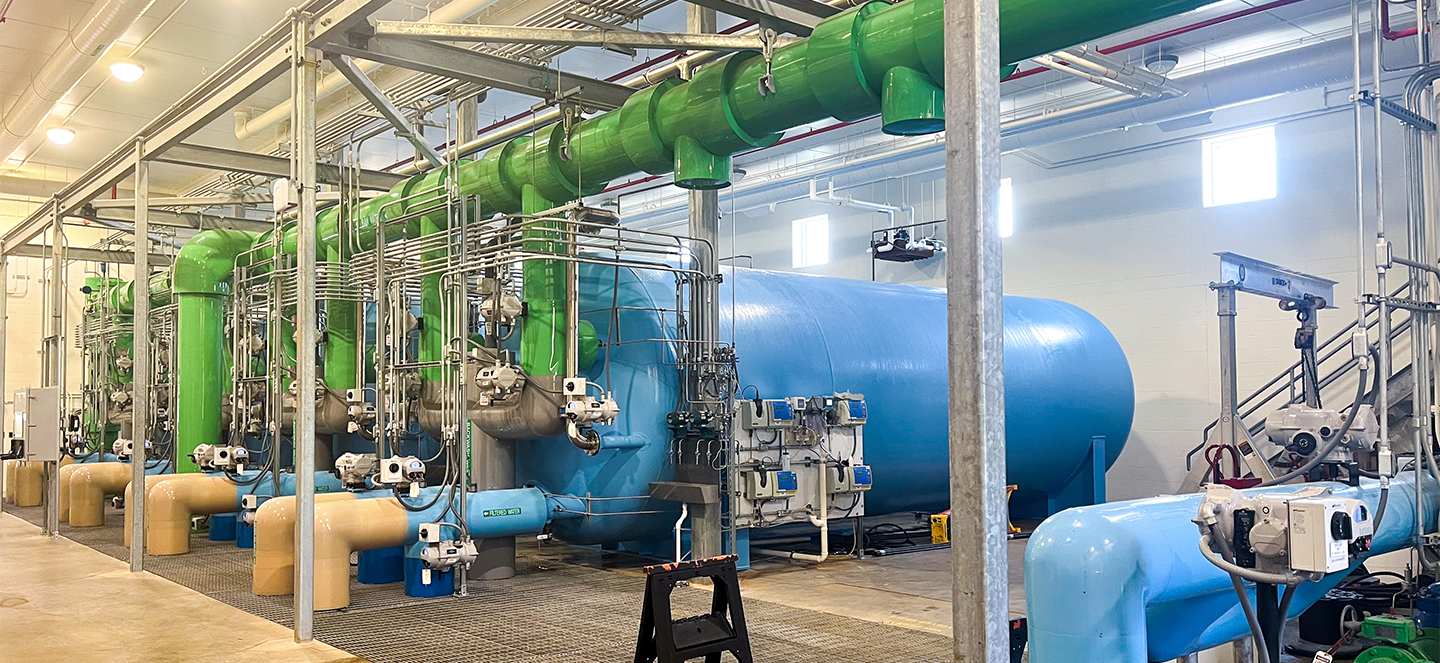On any given day, the MSU Water Treatment Plant pumps about 4 million gallons of water to ensure the 60,000 students, faculty and staff on campus can fill their water bottles, flush toilets and wash dishes.
Water chugs through the power plant to create steam that powers the university, heats buildings in the winter and cools them in the summer. When cheering crowds flock to Spartan Stadium or fill the Breslin Center, the water plant is ready to meet the extra demand.
Each year, at least 1 billion gallons of water flow through the $21 million MSU Water Treatment Plant, which was built in 2020. That’s what it takes to keep a campus as large as a mid-size city running. Water Works Supervisor Tom Silsby and his team are there to make sure MSU’s water is safe and clean, meeting state and federal requirements.
“When you sit and think about it, it’s kind of intimidating,” Silsby said of the seriousness of his job. “My rule of thumb is I make sure the water is safe for my family to drink. If it’s Safe for your family, it should be safe for everyone else.”
Ensuring water quality
The modern plant replaced the 1940s facility that pumped well water throughout campus up until four years ago. The older facility was expanded in the 1980s, but by 2020, it had served its purpose. While the old plant disinfected water, it didn’t filter out minerals like iron and manganese. MSU officials wanted to find a way to deliver a higher quality water to the campus.
The new plant uses a chemical process to oxidize dissolved iron and manganese to filter it out of the water. Radium also bonds to any manganese in the water, making it a large enough particle to filter out of the water.
Silsby said plant employees also add to the naturally occurring fluoride at recommended levels.
Right now, the water plant is chemically treating water distribution pipes for corrosion control, a process that was delayed during the pandemic.
Because few people were on campus in 2020 and 2021, the water demand was extremely low. The corrosion control chemical, however, needs a steady diet of water flowing through pipes. Now, the program is in full swing, and Silsby is confident that it’s working. University plumbers and building staff are also cleaning and maintaining faucet aerators in campus bathrooms, dorms and kitchens to make sure they don’t collect lead or copper.
A look inside the water plant
The entire facility is tucked behind an ID-protected fence. Cameras monitor each entrance 24 hours a day.
Inside the plant, water moves through giant blue filter tanks. Step into the filter room and you won’t hear water swishing through pipes. Because the system is pressurized, it’s quiet except for when workers clean the filters.
Dehumidifiers run constantly to combat the condensation that relentlessly drips from the tanks, especially in hot and humid weather. They’re painted with a special coating to prevent deterioration. Everything is kept as dry as possible and cleaned with either bleach or vinegar.
Water tower pressurizes system

The Michigan State University Water Treatment Plant was built in 2020 to ensure MSU’s water is safe, clean, and meets state and federal requirements. (Photo by Bethany Mauger)
You can’t miss the water plant on Recycling Drive– look for its 150-foot-tall water tower near the Surplus Store, adorned with the green Spartan helmet. The structure is built from panels of concrete and engineered to withstand winds up to 200 miles per hour.
The 2 million gallon-capacity tower maintains pressure throughout the water distribution system. The water’s weight at the top of the tower builds the pressure needed to push water through the pipes.
Silsby says the amount of water in the tower fluctuates depending on demand. At night, when activity is low, the tower’s water level slowly increases. Then, around 5 a.m., the tower is filled again to prepare for students getting up and starting their days. Employees keep an eye on the campus water usage and adjust throughout the day to meet demand.
On occasions like the start of football season, the Spartan community will receive a Red Water alert. Silsby said those are issued as a precaution as plumbers flush large amounts of water into Spartan Stadium or from fire hydrants. While the water is still safe, water might temporarily turn red from iron and not look very appealing.
Where does the water come from?
MSU doesn’t draw water from a river, stream or lake. Instead, water flows from 17 groundwater wells drilled 350 to 400 feet deep below research fields, campus sidewalks and city streets.
The water wells are cycled, following a formula to ensure that no well is pumped dry. The wells are mostly drought resistant, thanks to MSU’s central location in The Saginaw Aquifer with Great Lakes surrounding Michigan on three sides and rivers and streams crisscrossing the state.
While some of the wells are next to dairy and swine facilities, Silsby said their waste is land applied at safe levels and filtered through the earth to fertilize the topsoil. As groundwater trickles down from the surface, the Earth acts as a natural filter and removes nutrients. Meanwhile, the water picks up naturally occurring elements like iron and manganese. The water is filtered clean by the time it reaches the well about 10 years later, Silsby said.
Each month, the wells are tested for total coliforms, which indicate the presence bacteria from human or animal waste. Additional samples are collected and tested at four spots along the distribution system, including at MSU research farms. Then, another 10 bacteriological samples are collected at the northern end of campus. Any positive tests trigger an automatic test for E-coli. A positive E-coli result would require a public notification.
Once water reaches the plant, operators conduct weekly Water Quality Parameter testing to control pipe corrosion from copper and any lead that was used to solder pipes together. Other tests are performed each day for operational control, in accordance with regulations by the Environmental Protection Agency (EPA) and the Michigan Department of Environment, Great Lakes and Energy (EGLE).
All told, the plant conducts about 13,000 tests each year to ensure MSU’s campus has safe, high-quality water.
“We do a very rigorous testing regimen to ensure the safety and quality of the water on campus,” Silsby said.
Silsby knows his job is crucial. Whether MSU is quiet for the summer or bursting with screaming football fans, people count on clean, safe water when they turn on a faucet. Each day, Silsby and his staff makes sure the water plant is ready to meet that need.
Story by Bethany Mauger

